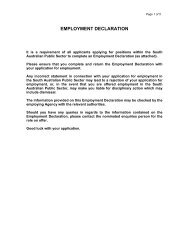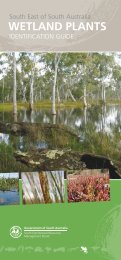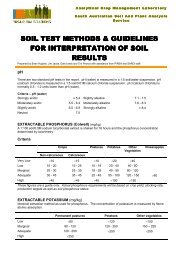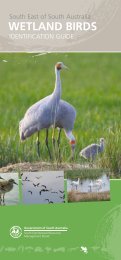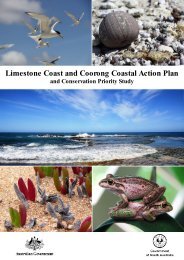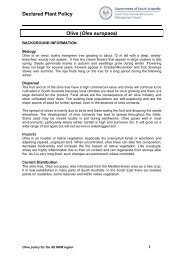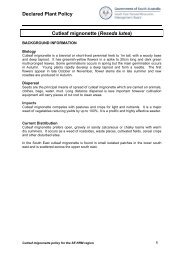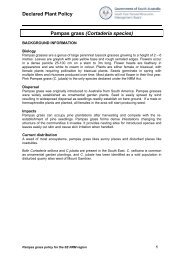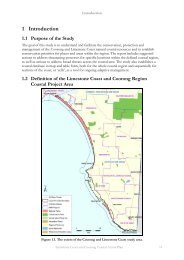Cell Descriptions - South East Natural Resources Management Board
Cell Descriptions - South East Natural Resources Management Board
Cell Descriptions - South East Natural Resources Management Board
Create successful ePaper yourself
Turn your PDF publications into a flip-book with our unique Google optimized e-Paper software.
SE13 – Kingston SE<br />
Climate change<br />
element/ scenario<br />
throughout this<br />
cell<br />
Sea level rise:<br />
2030 : +c.20cm<br />
2070: +c.80cm.<br />
Storms:<br />
Frequency continues<br />
to show great<br />
variation on a<br />
decadal scale.<br />
Intensity of large<br />
storms increases.<br />
Warmer average<br />
conditions:<br />
2030:+0.3 to.6 0 C<br />
2070:+1.5 to 2 0 C<br />
Drier average<br />
conditions:<br />
2030: -2% to 5%<br />
2070: - 10% to 20%<br />
‘Flashy’ run off:<br />
Drier creeks, but<br />
larger rare floods<br />
Groundwater<br />
lowering; saline<br />
Impacts and implications Protect and manage Address landscape<br />
(for this cell) habitat threats issues: fire,<br />
connectivity,<br />
refuges, hydrology<br />
rectified aerial<br />
photographic record at<br />
an appropriate<br />
resolution. .<br />
Increase in beach recession,<br />
storm foredune damage and<br />
dune instability.<br />
Acceleration of calcarenite<br />
cliff erosion.<br />
Foredune damage could lead<br />
to widespread dune destabilisation<br />
and transport of<br />
sand across dunes to<br />
swamps lakes.<br />
2030: Occasional storm tide<br />
flooding above highest<br />
known tides.<br />
2070: Flooding will affect<br />
both swamps and adjacent<br />
low lying areas. At the 2m<br />
inundation many<br />
connections between<br />
floodwaters occurs (Lidar<br />
survey).<br />
Frequent storm damage to<br />
foredunes.<br />
(Impacts uncertain. Existing<br />
terrestrial vegetation is<br />
found in warmer conditions<br />
elsewhere)<br />
Dune vegetation adapts to<br />
drier conditions, but<br />
recovers more slowly from<br />
fire and storm damage<br />
allowing weed colonisation,<br />
notably exotic grasses: dune<br />
mobilization becomes more<br />
likely.<br />
Reduced runoff and<br />
increased evaporation<br />
threatens seasonal lakes and<br />
lakeshore habitats.<br />
Drains and creeks may<br />
increase sediment load to<br />
coastal swamps and lakes<br />
(this depends on land<br />
management practices).<br />
Groundwater lowering a<br />
seasonal threat to valuable<br />
Active management of<br />
dune blowouts.<br />
Maintain an aerial<br />
photographic record of<br />
change.<br />
Create buffer zone to<br />
allow dune retreat where<br />
feasible.<br />
Manage sill on Butchers<br />
Gap drain tidal inlet to<br />
adjust to higher marine<br />
storm elevations as part<br />
of the adaptive<br />
management of the<br />
swamps and the drain<br />
outlet.<br />
Active management of<br />
dune blowouts.<br />
Active weed control<br />
within dunes. Manage<br />
blowouts.<br />
Monitor seasonal water<br />
levels in lakes. Adaptive<br />
management of<br />
ecological assets.<br />
Maintain watching brief<br />
on sedimentation of<br />
lakes and swamps.<br />
Adaptive management<br />
of ecological assets.<br />
The creation of<br />
buffer zones to<br />
allow retreat of tide<br />
dependant<br />
ecosystems a<br />
regional issue with<br />
local implications.<br />
Maintain<br />
connectivity of<br />
vegetation within<br />
the region.<br />
Lowering of<br />
regional water table<br />
Limestone Coast and Coorong Coastal Action Plan 430



